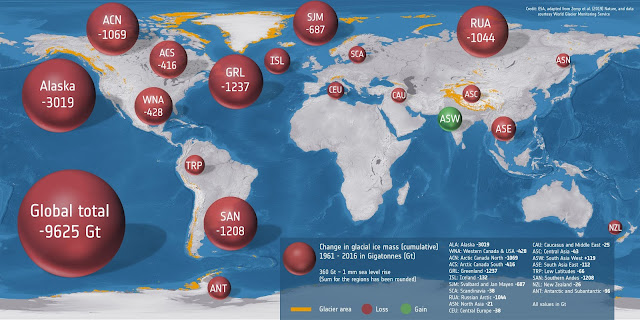Glaciers Around the World Disappearing At Record Pace
Credit: ESA, adapted from Zemp
& al.(2019) Nature & World Glacier Monitoring Service
Thawing glaciers contribute to the global sea level
rise. Scientists now discover how rapid and disastrous the consequences could
be.
According to the latest research published in the
journal “Nature”[1], scientists from University
of Zurich found that the ongoing glacial mass loss accounts for 25 to 30
percent of the total observed sea level rise in recent times.
The data indicates that between 1961 and 2016 global
glaciers lost more than 9,000 billion tons of ice, resulting in an increase of
sea levels by 2.7 centimeters. The findings show that the greatest contribution
to the rising levels emanates from the melting of the glaciers in Alaska,
followed by the ice fields in Patagonia and the Polar Regions.
“Globally, we lose about three times of the ice volume
stored in the entirety of the European Alps – every single year!” says
glaciologist Michael Zemp, who leads the mentioned research project. His
team combined glaciological field observations with geodetic satellite
measurements, which allowed them to reconstruct changes in the ice thickness of more than
19,000 glaciers worldwide.
The Possible Impacts
In fact, around 68% of fresh water on earth is stored
in glaciers and ice caps, which comprise crucial freshwater sources to various
regions.
In the Himalayas, the changes of the cryosphere (snow,
ice, permafrost) fuel the climate impact, affecting the timing and seasonal
distribution of runoffs. Such effects put direct risks to the communities that
depend on glacial water for subsistence.
The current glacier-melt water release also expands
the potentially perilous glacier lakes, increasing the danger of flooding, and
worsening the permafrost degradation. Beyond that, such consequences might even
destabilize high mountain slopes and peaks. The resulting debris flows threaten
the local transportation infrastructure[2],
posing further strains to local livelihoods.
Ice cliff on debris-covered Khumbu Glacier, Nepal Himalaya, November 2016 (photo: J. Shea)
The speed of glacial melting in Alps regions also concerns
many scientists. According to the latest article published in the journal “The
Cryosphere”, half of the glaciers within the region will disappear before 2050,
despite the possible efforts being made to mitigate the global warming in the
coming years.
Alps Mountains are not just a touristic destination,
they function as reservoirs from which the fresh water is drawn for irrigation
and electricity generation by the surrounding nations. Recently, the rarity of
water resource resulting from the shirking glaciers has begun to modify the
entire maintain ecosystem and landscapes.
The reddish zone marks the internal rocks
appealing after the glaciers retreat in Alps
Credit: GLIMS and NSIDC (2005,
updated 2018)
Why the Ice Matters
Many experts connect the accelerating sea level rise to the
unprecedented melting of ice caps covering Antarctica and Greenland. Once land
ice melts, the water quickly floats into the oceans and increases its total
volume. One common misconception has to be clarified is the myth that ‘melting
sea ice contributes to the sea level rise.’ This is incorrect.
“Melting
sea ice has no impact on sea level rise because it’s already floating in the
ocean,” explained Axel Schweiger, researcher at the University of Washington.
Just like a glass of ice water, once the ice melts, the total water volume
stays the same. “However, melting sea ice does contribute to climate change.”[3]
The reason for that is because white sea ice reflects the sunlight. When
it gradually disappears, it forms a vicious climate cycle in which dark ocean
water starts to absorb more sunlight, thus heating up and lifting the overall
global temperature, which, at the same time leads more land ice to melt.
If no drastic actions are taken to alleviate the rising temperature,
certainly, more disasters are foreseeable within this century: submerging
island nations, devastating weather conditions, poverty, and famine all
deriving from the harsher climate and scarce accessibility to fresh water.
By Chris Chang x Green News Taiwan
[1] https://www.nature.com/articles/s41586-019-1071-0
[3] https://www.yaleclimateconnections.org/2014/11/loss-of-land-ice-not-sea-ice-more-sea-level-rise/




Comments
Post a Comment